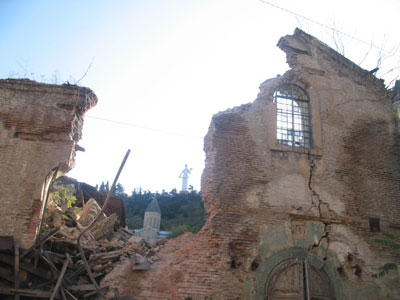Samvel Karapetyan – “We mourn the collapse of Saint Gevorg of Mughni Church in Tbilisi. But what about the fate of St. Nishan’s, just 100 meters away?
The Saint Gevorg of Mughni Armenian Church in Tbilisi had a height of some 35 meters and an attractive design, especially on the eastern exterior façade where there were depictions of the benefactors and main altar. There were only two churches with a similar footprint in all of Georgia. The other is St. Mesrop Church in the Shahumyan (formerly Metz Shulaver) settlement in the Marneuli region.
On November 19, the dome of St Gevorg’s came crashing down and the church collapsed. Samvel Karapetyan, who heads the Armenian Architectural Research NGO spoke to “Hetq” about the incident and its significance.
-Did St. Gevorg’s collapse due to the fact that it was no longer structurally sound?
-Yes, the church structure was unsafe. But this was a result of many decades of neglect. It was Georgia that saw to it that the church deteriorated to the point of collapse. That’s to say, the lead up to the collapse was the result of a specific policy. Normally, if a structure that possesses some historical value is on the verge of collapse, immediate measures are taken to fortify and secure the building. For example take our churches at Ani that aren’t on the verge of collapsing, some that have only one or two loose stones. The Turks have set up support beams and braces. The same should have been done in the case of St. Gevorg in order to fortify the structure, despite being unsound. The Georgian government can now state ‘we don’t have the requisite funds’, but structural fortifications could have been placed at fairly low cost.
-Did anyone raise this concern with the Georgian government? That the church was prone to collapse without necessary renovations?
-I know that in 1990, at the end of the Soviet regime, Armenia’s Department of Monuments’ Preservation raised the issue, but I have no knowledge if the issue was raised since then, in the past twenty years. I would assume that it wasn’t.
-Wasn’t St. Gevorg’s an Armenian church that had been Georgianized?
-No, it hadn’t been subjected to this process. The Georgians were well aware of the church’s poor structural condition and that it would eventually collapse in a few years anyway. That’s why they left it alone. Had it been co-opted, the Georgians would need to have spent huge amounts to repair and renovate the church. In addition, St. Gevorg’s of Mughni, is a church that has played a prominent role on the life of the Armenian community of Tbilisi. Had the Georgians sought to co-opt the church, it would have created a great deal of commotion. Thus, they decided that it would be more convenient for them in the long-run to keep the church in a state of disrepair and wait for its eventual collapse. During the years 1988-1989, the church served as the Folk Arts Museum. There were various exhibits displayed inside. In 1989, the museum moved and so did all the items on display. At the time, the walls were already showing hairline cracks. I had occasion to visit the church last year. The cracks had grown so large that one could pass through the walls and enter the church. In the twenty years since 1989, one can honestly state that the church’s eventual collapse was the result of official design.
-In your estimation, does it now even make sense to talk about the rebuilding of St. Gevorg’s?
-Believe me, restoration of the church is a moot point. First of all, the church was a brick structure and when such a church collapses all that’s left is a pile of useless rubble. The same fate befell the Shamkoretsots Karmir Avetaran Church in Havlabar (an historic Armenian neighborhood in Tbilisi) that was blown up in April, 1989. It too was beyond rebuilding since it was a brick structure as well and had been transformed to a heap of rubble. I am convinced that we have lost St. Gevorg of Mughni forever. We didn’t raise the issue of the blowing-up of the Karmir Avetaran Church and now, this church, collapsed on its own. Back then, the Armenian community proposed to the government that they be allowed to pay for the renovation of Shamkoretsots. They not only refused the request but blew-up the church as well. I can’t say if the Armenian community made a similar request to the government regarding St. Gevorg’s. My guess is that they haven’t. Why? Just take a look at the condition of St Nishan’s. We have about 80,000-100,000 Armenians in Tbilisi alone and many more throughout all of Georgia. Several years ago the church was set ablaze. It still stands but after the fire it’s become deserted; a semi-ruined structure that is now used as a public toilet. And this is sacrilege is happening before the eyes of the Armenian community in Tbilisi. St Gevorg’s and St. Nishan’s are in close proximity to one another; separated by a mere 100 meters or so. One has collapsed due to years of neglect and we have no knowledge of any official petition by the community or the Diocese (yes, we do have an official Church See there) to the Georgian authorities expressing the desire or will to renovate it. This is also true for St. Nishan’s. Today we mourn the loss of St. Gevorg’s but what about the condition of St. Nishan’s, a church that still stands? Does it await the same fate?
 Videos
Videos Photos
Photos





Write a comment